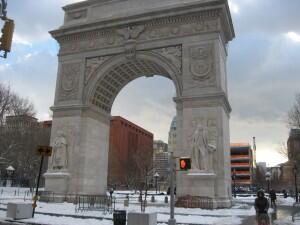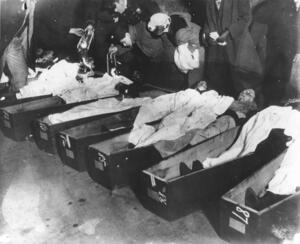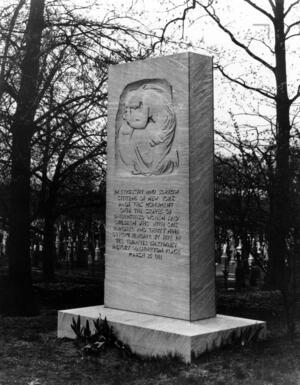Washington Square Park
A week after the Triangle fire, a large funeral procession organized by Jewish unions set out from the Forward building. Another procession, made up mostly of non-Jewish union members, suffragists, and socialists, met them at Washington Square. The two groups, numbering over 140,000, marched through a driving rain up Fifth Avenue; close to 250,000 others stood along the route. As a gesture of solidarity and respect for the dead, the marchers carried no political or religious symbols.
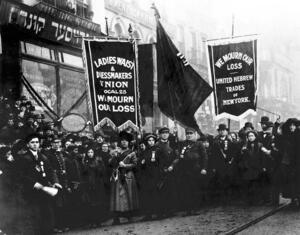
The funeral parade for the unidentified victims of the Triangle fire was held on April 5, 1911. Jewish union members met the non-Jewish unions, middle-class suffragists, and socialists in Washington Square Park and marched together through a driving rain up Fifth Avenue. Pictured here are members from Local 25 of the Ladies Waist and Dressmakers Union and the United Hebrew Trades of New York during the funeral procession.
Courtesy of the International Ladies' Garment Workers' Union Archives, Kheel Center, Cornell University.
While a majority of the workers at the Triangle fire were Jewish immigrants, the disaster quickly became an American tragedy—one to which the labor movement, the City of New York, and the Jewish community each laid claim.
Immediately after the fire, coroners had taken the bodies to a temporary morgue where for four days, survivors, family members, and friends waited in the rain for a chance to walk up and down the rows of corpses, many burnt beyond recognition. By March 30th, all but seven of the bodies had been identified. Fraternal orders, landsmanshaft societies, and synagogues came forward to bury their members. Communal agencies as well as other charitable organizations helped families without such affiliations.
But what would happen to the unidentified dead? Where would they be buried? What prayers would be said? Within days of the fire, labor organizers, the Jewish community, and the city were at odds over who should memorialize the unknown victims.
Unions saw the fire as a terrible and avoidable tragedy, one that could be used to win support for labor causes. Representatives of the International Ladies Garment Workers Union (ILGWU) and the Women's Trade Union League (WTUL) asked the city to allow them to have a public funeral for the unidentified victims. A public funeral would emphasize the universality of the tragedy and direct attention to the poor working conditions in factories, the need for reform, and the role of unions in fighting for the working class.
While the unions had a large Jewish following, the Jewish clergy objected to politicizing a religious ritual. Many in the Jewish community felt that the unidentified victims should be given a Jewish burial and were offended by the idea that the city would conduct a private funeral.
Meanwhile, Christians—particularly Catholics, who knew that many Italian immigrants had worked at the factory—were opposed to administering Jewish funeral rites to the unidentified victims, one or more of whom might not be Jewish.
With religious and labor groups vying to bury the unidentified dead, the mayor determined that the city should take charge—it would pay the funeral costs and bury the dead at a non-denominational cemetery in Brooklyn.
The decision sparked protest among union supporters. Three days after the fire, Local 25 of the ILGWU, the Women's Trade Union League, and the Workman's Circle distributed flyers in English, Yiddish, and Italian announcing that "a great silent procession" would take place on Wednesday, April 5th.
This procession began on the Lower East Side at the Forward building. Six horses pulled an empty hearse, followed by survivors of the fire and members of 60 different ILGWU locals. Meanwhile, non-Jewish union members, socialists, and middle-class suffragists began their procession at Fourth Avenue and 22nd Street.
At Washington Square Park, the two processions converged. Arm-in-arm at the head of the march were three officers of the Women's Trade Union League (WTUL) including Rose Schneiderman, a former garment worker and union organizer, who three days earlier had given an impassioned speech at a meeting to memorialize the fire victims at the " Metropolitan Opera House.
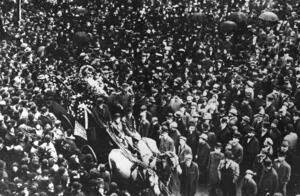
The crowd at the Triangle funeral parade. More than 140,000 mourners met on April 5, 1911 in Washington Square Park and marched up Fifth Avenue in a funeral parade in memory of the unidentified victims of the Triangle fire. Nearly 250,000 onlookers lined the route.
Courtesy of the International Ladies' Garment Workers' Union Archives, Kheel Center, Cornell University.
Schneiderman marched with her WTUL colleagues, Mary Dreier, the wealthy suffragist and labor supporter, and Helen Marot, secretary of the League, in "the largest demonstration ever made here by working people," as the New York Times reported. The march "practically emptied the downtown and Brooklyn lofts and factories."
Meanwhile, a small group of city officials accompanied the unidentified victims from the morgue to the Brooklyn cemetery where a Catholic priest, an Episcopalian minister, and a rabbi officiated at a private ceremony. In 1912, with little fanfare, a monument created by sculptor Evelyn Longman would be placed at the site. Union leaders erected their own memorial, an eternal flame, next to the plots of 14 victims in a Jewish cemetery in Queens.
In the aftermath of the fire, city and state politicians recognized that the public expected them to take action to improve working conditions. "I can't begin to tell you how disturbed the people were everywhere," the future cabinet secretary Frances Perkins recalled many years later. "It was a terrible thing for the people of the City of New York and the State of New York to face."
In the spring of 1911, the governor of New York created a Factory Investigating Commission, whose members spent five years inspecting factories in every corner of New York State.
The Commission wrote more than 35 bills, which the New York State Legislature adopted. The result was a sweeping revision of the state's labor code and the adoption of fire safety measures that would be a model for the whole country.
Among the commission members was Frances Perkins, who connected the Triangle fire to the enactment of new legislation that protected working people. She said many years later that the laws seemed "in some way to have paid the debt society owed to those children, those young people who lost their lives in the Triangle Fire."
Other states followed New York's lead, and with pressure from labor unions and support from the Roosevelt Administration, the federal government eventually enacted laws stipulating minimum wages, maximum hours, unemployment insurance, and an end to child labor.

